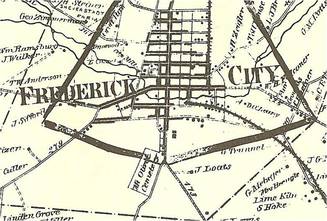 Mount Olivet Cemetery on 1858 Bond Atlas map of Frederick, Maryland Mount Olivet Cemetery on 1858 Bond Atlas map of Frederick, Maryland In the early 1850’s, well before the outbreak of the American Civil War, Frederick City consisted of many downtown-located burying grounds. Most of these adjoined churches and dated back to the founding of Frederick Town in the 1740's. As the town's population grew, so did the churches and their congregations. The graveyards were rapidly reaching capacity for burials. At the same time, churches wanting to expand their structures found themselves "land-locked" thanks to church graveyards abutting or encircling their main structure. A committee was soon formed, comprised of prominent member-representatives from each church. These folks would represent the interest of their individual congregations and discuss a resolution to the problems of not having enough burial space. It was decided that a new cemetery would have to be developed to cater to the needs of an ever-growing Frederick and her religious institutions. This was at the height of the "rural," or "garden," cemetery movement, a new school of thought which began in the large cities of the northeast. Herein, the philosophy toward cemetery design was re-examined. Prior to this time, small urban churchyards were the norm, but the "garden" cemetery movement promoted larger, park-like spaces on the outskirts of town. These cemeteries were planned as public spaces from their inception, and provided a place for all citizens to enjoy refined outdoor recreation amidst art and sculpture. Elaborate gardens were planted and family outings to the cemetery became popular social activities. 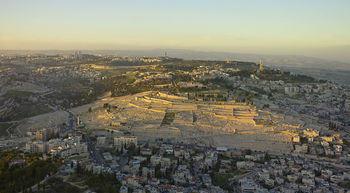 Jerusalem's Mount of Olives (Israel) Jerusalem's Mount of Olives (Israel) What's in a Name? The name Mount Olivet was chosen, perhaps a curious choice for a non-denominational burying ground. The famed Mount of Olives, or Mount Olivet, is a mountain ridge east of, and adjacent to, Jerusalem's Old City. It is named for the olive groves that once covered its slopes. The southern part of the Mount was the Silwan necropolis, attributed to the ancient Judean kingdom. The Mount has been used as a Jewish cemetery for over 3,000 years and holds approximately 150,000 graves. Several key events in the life of Jesus, as related in the Gospels, took place on the Mount of Olives, and in the Acts of Apostles it is described as the place from which Jesus ascended to heaven. The Charter of Mount Olivet Cemetery was recorded among the Land Records of Frederick County on October 4th, 1852. Thirty-two acres were purchased through stock sales, and a rural architect from Baltimore named James Belden was hired to design and lay-out Frederick's new burying ground. The cemetery was dedicated on May 23rd, 1854 amidst great fanfare. The cemetery's first interment occurred on May 30th, 1854. This was Mrs. Ann J. Crawford, around 67 years of age, a house maid working for the family of James Whitehill, a prominent Frederick businessman and one of the founders of the cemetery. 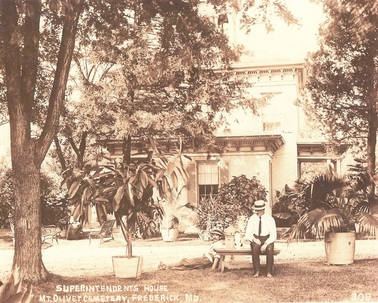 Vintage 1909 photograph of the cemetery with a few decorative plants on the grounds. Vintage 1909 photograph of the cemetery with a few decorative plants on the grounds. Victorian Style, "the Language of Flowers"and Symbolism Mount Olivet’s grounds are made up of hundreds of individual lots, each belonging to individual families. Though little more than cleared farmland in the beginning, early depictions show that many hedges were installed to delineate these property lines and young trees were planted to break the heat of the summer sun. Today these saplings are towering giants that pay homage to all who have passed beneath them. The families continued developing their lots and pictures from the turn of the century show the refinement that had occurred. Walls, fountains and ornate iron fences had been added to grace the gardens. The Victorian Period (1837-1901) defines the period of Queen Victoria's reign over Great Britain. This measured era of both European and American history brought a fascination with the natural world and a keen interest in plants. It became quite fashionable to decorate one's home with exotic, often tropical, plants. This would carry over to cemeteries as well. Palm trees and other rare species (to Maryland) would become part of the Mount Olivet landscape here, necessitating the cemetery's first greenhouse, built to "winter" these tender plants in addition to growing flowers. Many plants and flowers were symbolic to those of the Victorian Age, either through their ‘language of flowers’ or religious beliefs. Lilies, symbolizing resurrection, weeping willows for sorrow and palm fronds and laurel to indicate triumph of the soul are frequently seen on grave markers. Bouquet could be used to send a private message telling of one’s love, or hate. You could also see these plants growing nearby within the cemetery, and in other cases, actually carved in stone on monuments. 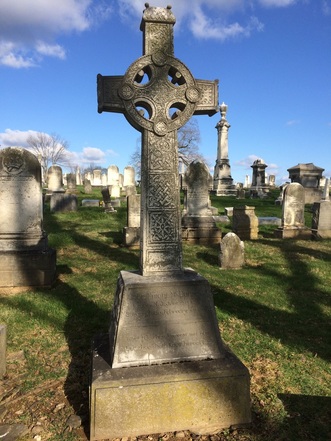 Perhaps no other area of study offers better insight into the Victorian-era fascination with symbolism than that of the nineteenth century cemetery. Even the word "cemetery" has symbolic overtones as it was adapted by the early Christians from the Greek word koimerterion meaning "place of sleep." All cemeteries built during the Victorian period are full of symbolic references from the cemetery's design to the motifs and the design on the monuments. Crosses, obelisks, urns, columns, anchors, angels, cherubs adorn the older sections of the property and send some sort of message about the personality or importance of the inhabitants buried beneath. The connection of stone and religion is strong. Stone conveys images of firmness and timelessness. It is quite natural that both Western and Eastern religions have embraced the use of stone as a media for their grave memorials. The messages conveyed on stone will in theory be eternal and mark an individual's life on earth. Today, in excess of 40,000 graves are occupied, rivaling the living population of our state capital of Annapolis. Eight miles of paved roadway criss-cross the spacious cemetery grounds, allowing for recreational usage by walkers, runners and cyclists acting in a reverent and respectable manner. In addition, the cemetery proudly welcomes history and art lovers, family genealogists, photographers and "tombstone tourists" of all ages.
3 Comments
Jocelyn Wetzel
11/18/2016 09:36:32 pm
Beautiful blog. Keep up the good work.
Reply
Sarah Drenning
11/28/2016 10:46:35 pm
I'm happy to have come across this and found it interesting reading.
Reply
Nancy Droneburg
5/18/2019 08:06:15 pm
Wait all the time for the next history lesson.
Reply
Leave a Reply. |
STORIES
|
Archives
July 2024
June 2024
May 2024
April 2024
March 2024
February 2024
January 2024
December 2023
November 2023
September 2023
August 2023
July 2023
June 2023
May 2023
April 2023
March 2023
February 2023
January 2023
December 2022
November 2022
October 2022
September 2022
August 2022
July 2022
June 2022
May 2022
April 2022
March 2022
February 2022
January 2022
December 2021
November 2021
October 2021
September 2021
August 2021
July 2021
June 2021
May 2021
April 2021
March 2021
February 2021
January 2021
December 2020
November 2020
October 2020
September 2020
August 2020
July 2020
June 2020
May 2020
April 2020
March 2020
February 2020
January 2020
December 2019
November 2019
October 2019
September 2019
August 2019
July 2019
June 2019
May 2019
April 2019
March 2019
February 2019
January 2019
December 2018
November 2018
October 2018
September 2018
August 2018
July 2018
June 2018
May 2018
April 2018
March 2018
February 2018
January 2018
December 2017
November 2017
October 2017
September 2017
August 2017
July 2017
June 2017
May 2017
April 2017
March 2017
February 2017
January 2017
December 2016
November 2016






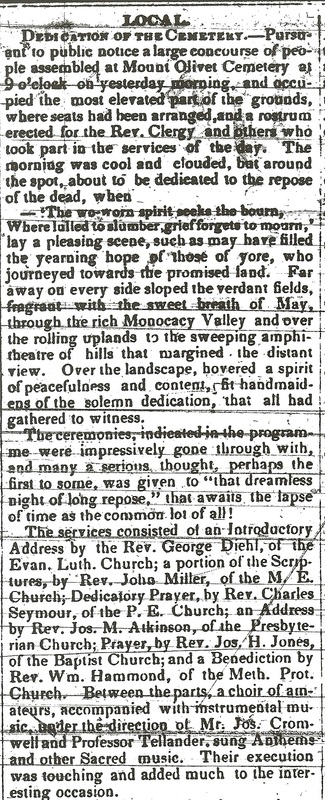

 RSS Feed
RSS Feed